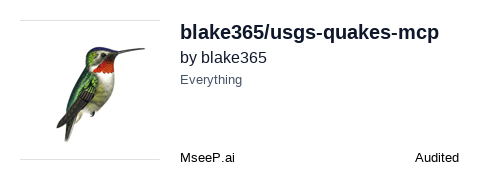About
Provides AI assistants with quick, natural‑language queries to the USGS Earthquake API, enabling searches for earthquakes by region, magnitude, time range, and retrieval of detailed event information.
Capabilities

Overview
The USGS Quakes MCP server bridges the powerful capabilities of Claude Desktop with the rich, real‑time earthquake data provided by the United States Geological Survey. By exposing the USGS Earthquake Hazards Program API through MCP, developers can turn natural‑language queries into precise geospatial searches and retrieve detailed event information without writing any HTTP requests or parsing JSON manually. This dramatically lowers the barrier to incorporating seismic intelligence into conversational agents, data‑analysis pipelines, or custom dashboards.
Problem Solved
Earthquake information is scattered across multiple web endpoints and often requires manual filtering, coordinate conversion, and interpretation of complex response schemas. For AI assistants that need to answer questions like “What major quakes happened in Florida last 20 years?” or “Show me the depth and magnitude of a specific event,” this friction hampers quick, accurate responses. The MCP server abstracts these intricacies, allowing the assistant to focus on user intent while the server handles API authentication, parameter mapping, and result formatting.
Core Functionality
- Natural‑language query parsing: Users can pose questions in plain English, and the server translates them into appropriate API calls (e.g., searching by magnitude range, geographic bounds, or time window).
- Two primary tools:
- find‑earthquakes: Retrieves a list of events matching search criteria, returning bounding boxes and key statistics.
- find‑earthquake-details: Fetches exhaustive metadata for a single event, including depth, magnitude, station coverage, and intensity maps.
- Rich metadata delivery: Each response includes not only the core event data but also contextual details such as felt reports, intensity ratings, and station statistics that aid in risk assessment or public communication.
- Seamless integration with Claude Desktop: The server registers itself automatically through Smithery, making the tools immediately available in the assistant’s toolbox.
Value for Developers
- Rapid prototyping: Embed seismic queries into a chatbot or data exploration tool without worrying about API rate limits or request construction.
- Enhanced user experience: Provide instant, accurate answers to seismology questions, improving engagement for educational platforms or emergency response systems.
- Data enrichment: Combine earthquake data with other geospatial datasets (e.g., population density, infrastructure layers) to build comprehensive risk models.
Real‑world Use Cases
- Disaster preparedness apps: A municipal dashboard that alerts residents to recent seismic activity and offers safety guidelines.
- Educational tools: Interactive learning modules where students can query historical quakes and visualize their impact.
- Scientific research assistants: Researchers who need quick access to event catalogs for statistical analysis or machine‑learning feature extraction.
- Media reporting: Journalists can retrieve authoritative event details on demand to enrich news stories about seismic events.
Standout Advantages
- Zero-code integration: Developers and non‑technical users alike can leverage the server’s capabilities through a conversational interface, eliminating the need for custom scripting.
- Consistent data schema: The MCP server normalizes USGS responses into a predictable structure, simplifying downstream processing.
- Extensible design: The toolset can be expanded to include additional USGS endpoints (e.g., hazard zones, tsunami warnings) or other seismic agencies with minimal effort.
By encapsulating the complexity of the USGS API behind a conversational, MCP‑driven interface, the USGS Quakes MCP empowers AI assistants to deliver precise, context‑rich seismic information instantly—making it an indispensable asset for developers building safety‑critical or data‑driven applications.
Related Servers
Netdata
Real‑time infrastructure monitoring for every metric, every second.
Awesome MCP Servers
Curated list of production-ready Model Context Protocol servers
JumpServer
Browser‑based, open‑source privileged access management
OpenTofu
Infrastructure as Code for secure, efficient cloud management
FastAPI-MCP
Expose FastAPI endpoints as MCP tools with built‑in auth
Pipedream MCP Server
Event‑driven integration platform for developers
Weekly Views
Server Health
Information
Tags
Explore More Servers
Model Context Protocol Server
Unified API for multiple AI model providers
Souls Mcp Srv
A community-driven MCP server directory for instant deployment
PBIXRay MCP Server
LLM‑friendly Power BI model exploration
Korea Stock MCP Server
AI‑powered Korean stock analysis via DART and KRX APIs
Mcp Sandbox
Quickly test MCP servers in a local sandbox
Tradermcp
Fast, lightweight MCP server built with Bun for trading applications.